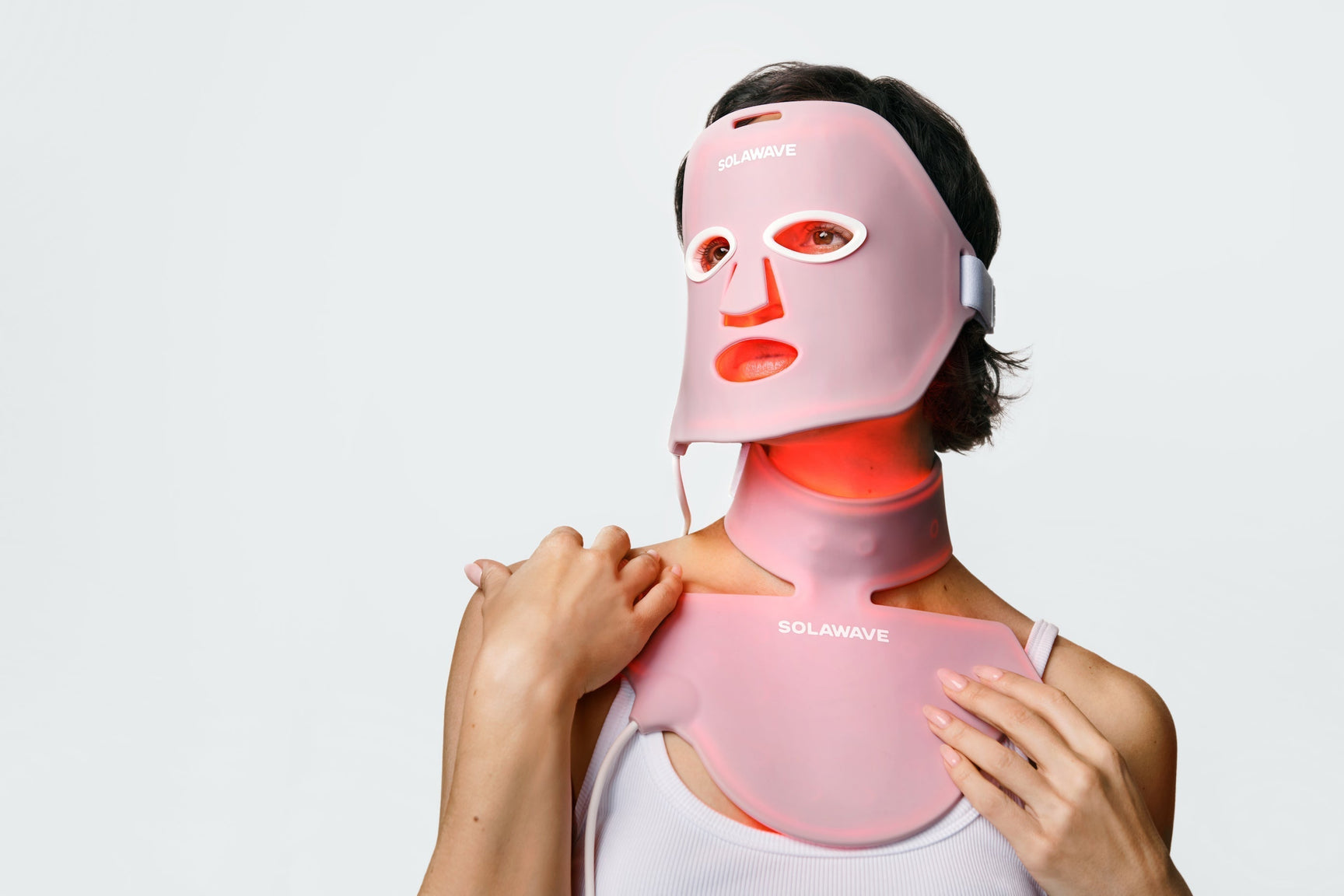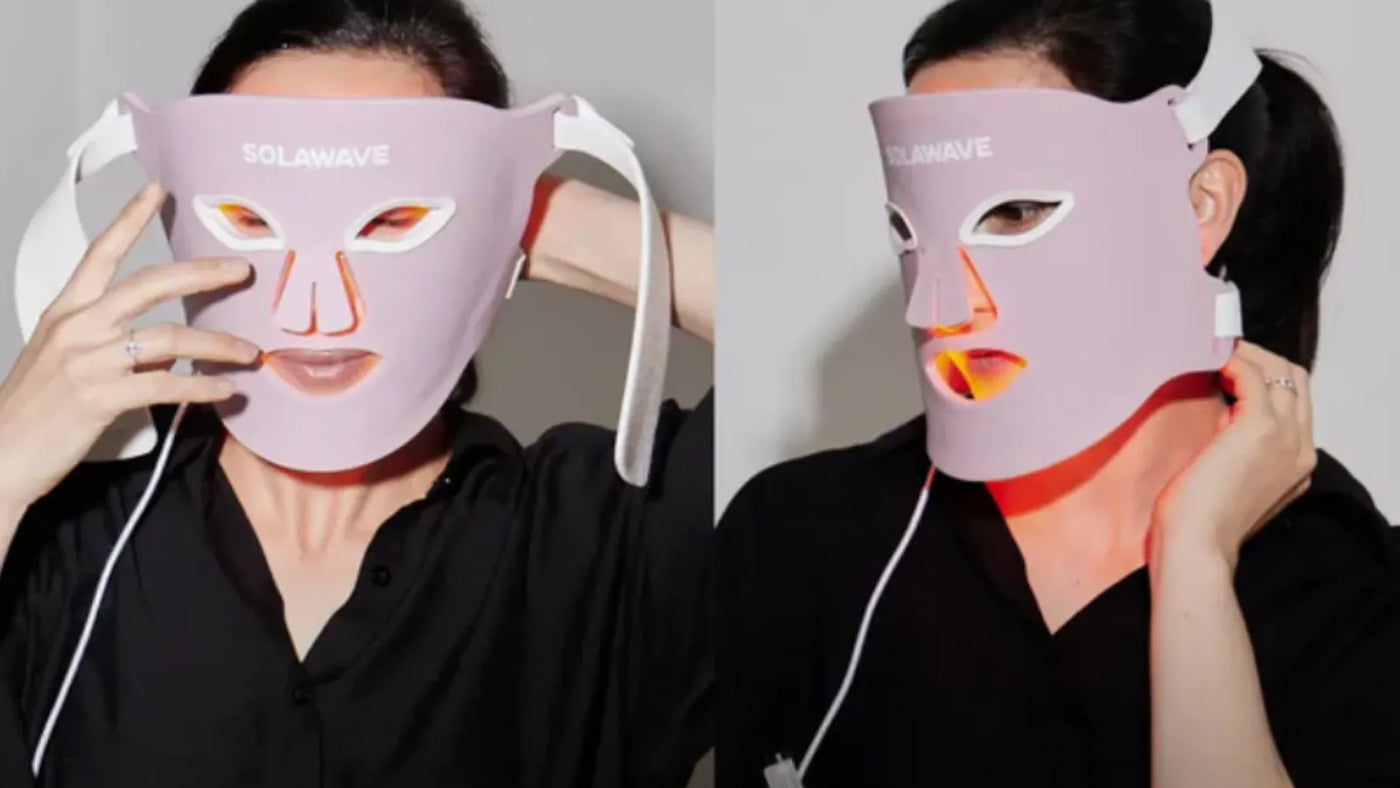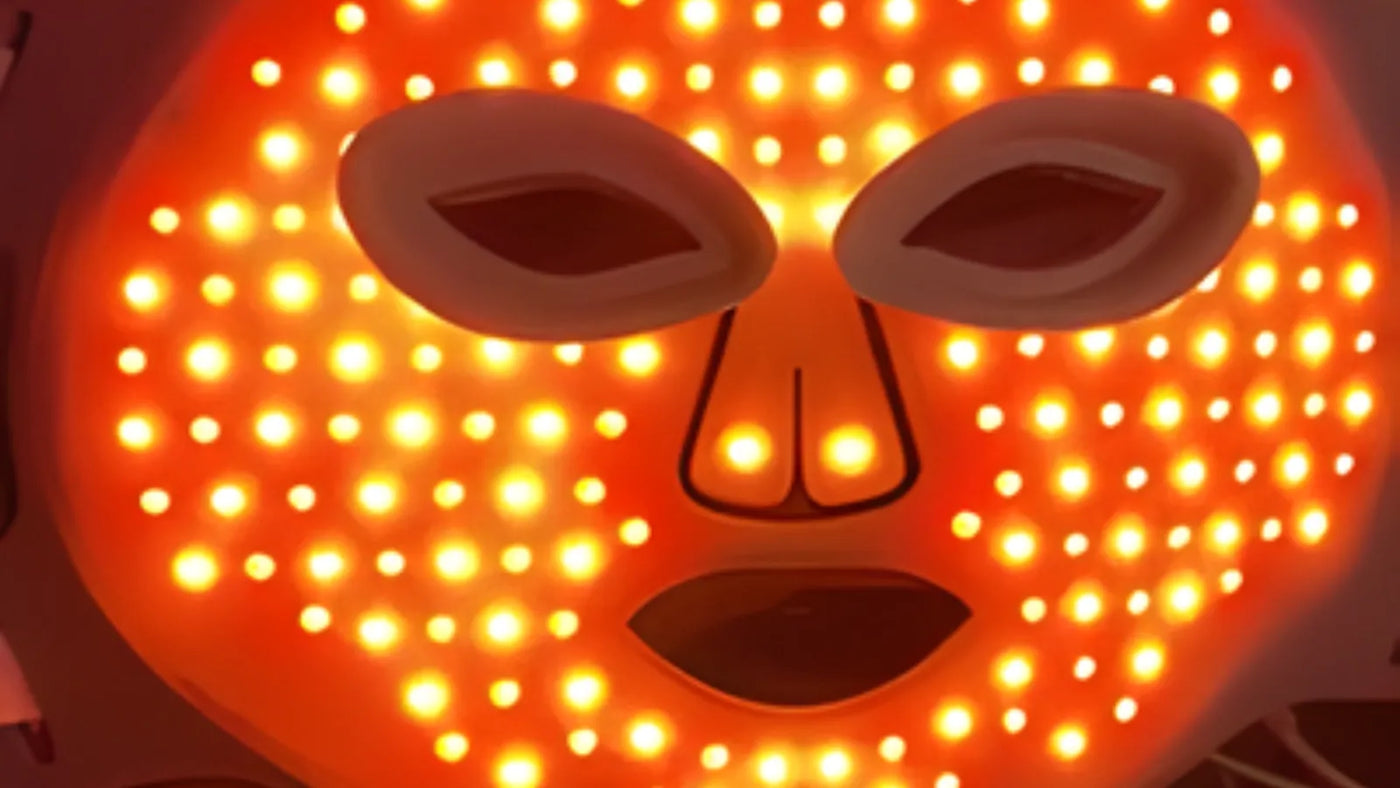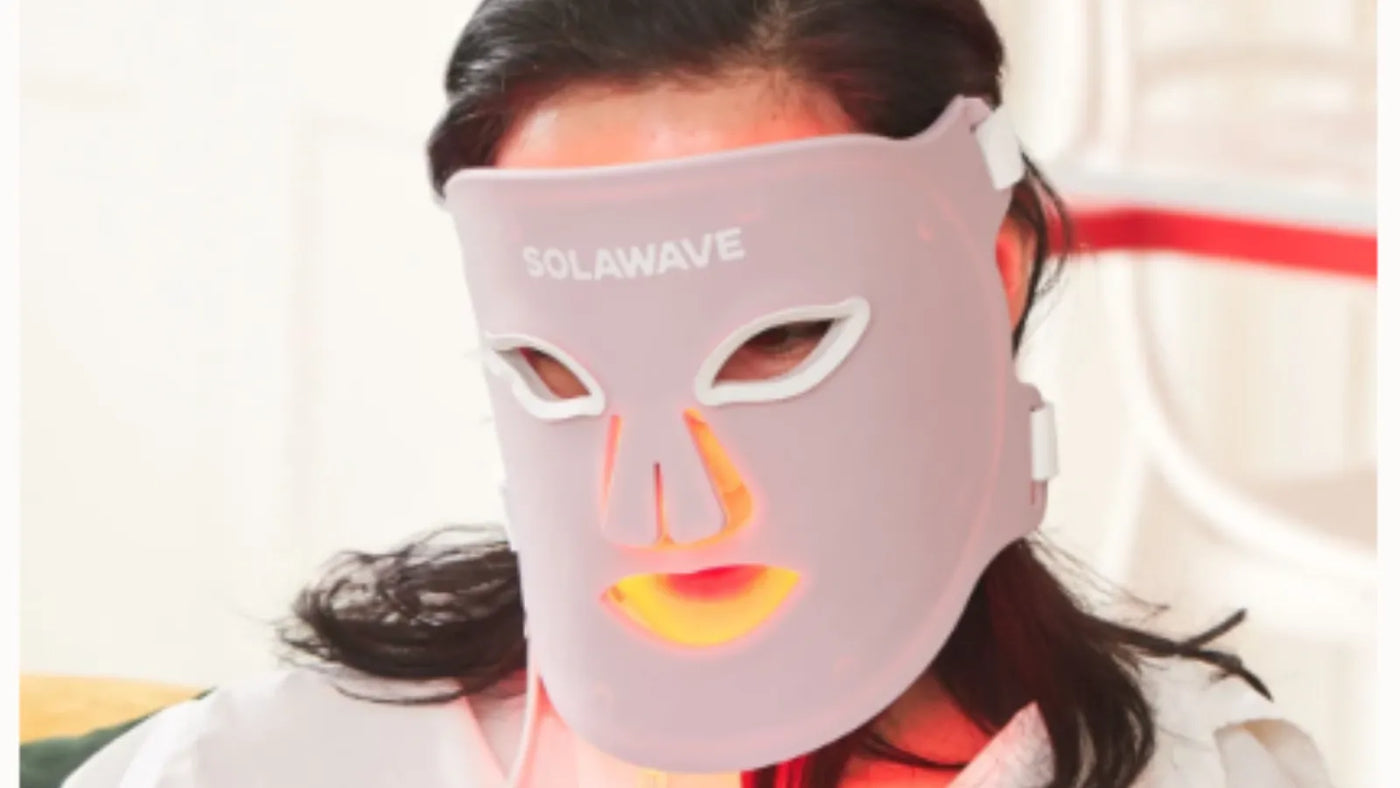

Red Light Panel vs Mask: Everything To Know
Red Light Therapy is making waves in both the wellness and skincare worlds, and for good reason. This innovative technology uses specific wavelengths of light to deliver a range of benefits depending on the device you're using, from supporting muscle recovery to visibly rejuvenating the appearance of your skin.
In this article, we're diving into the specifics of two popular forms: Red Light Panels and Red Light Masks. Whether you're an athlete looking to boost recovery or someone aiming to professionalize your skincare routine, you'll want to know the differences between these two options so you can find the device that fits best with your goals.
What Is Red Light Therapy and Why Does It Come in Different Forms?
Red Light Therapy is a non-invasive treatment that uses specific wavelengths of light to penetrate the skin and support various skincare and wellness goals.
In skincare, Red Light Therapy is celebrated for its ability to support healthy collagen production, which can ultimately reduce the appearance of fine lines and wrinkles and promote the look of youthful skin.
On the sports and recovery front, Red Light Therapy is a favorite among athletes and fitness enthusiasts for its ability to aid in muscle recovery, which can ultimately support healing and enhance performance.
That said, the device you use will make all the difference. Red Light devices for skincare and Red Light devices for athletes will not deliver the same benefits because they are each manufactured for specific uses that do not intersect because of how the devices are made and meant to be used.
Red Light Masks: Elevating Your Skincare Routine
Red Light Therapy in skincare is so popular because of Red Light's ability to target visible signs of skin aging. Pair that with the availability of professional-grade devices that can be used at home, and you have the reason why Red Light LED Masks are the talk of the anti-aging skincare realm.
While the best Red Light Therapy devices combine multiple types of Light Therapy, there are two main benefits you'll get from Red Light Therapy, alone: reduced appearance of signs of skin aging and visibly even tone and soothe redness
Targeting Visible Signs of Skin Aging
Red Light LED Masks are designed to reduce the appearance of fine lines and wrinkles, giving your skin a healthier, more glowy look. By supporting healthy collagen production, Red Light Therapy LED masks promote visible skin rejuvenation by targeting the issues caused by decreased collagen production.
For those looking to elevate their skincare routine, the Wrinkle Retreat Face Mask & LightBoost Cream Kit combines the power of Red and Near-Infrared Light Therapy to target visible signs of skin aging while promoting a look of overall radiance in the complexion. The included LightBoost serum works to boost the effects of both the Red Light Therapy and Near-Infrared Light Therapy while also nourishing skin with ingredients like multi peptides and polyglucuronic acid.
Acne and Puffiness Reduction
Red Light Masks can also be effective for reducing puffiness & redness. These masks work by visibly even tone, though Red Light alone can't target acne itself.
That said, Red Light Therapy can be combined with Blue Light Therapy, which does target acne-causing bacteria. We do just this with our Bye Acne 3-Minute Spot Treatment targets inflammation while also destroying acne-causing bacteria. It goes without saying that in skincare applications, Light Therapy isn't just limited to masks, but can also be implemented into handheld devices like this one for targeted skincare treatments.
Red Light Panels: The Sports and Recovery Powerhouse
Red Light Panels are a powerful tool for athletes and fitness enthusiasts aiming to enhance their performance and recovery. These panels deliver concentrated doses of red light, which penetrate deep into the muscles, offering a range of benefits.
Muscle Recovery and Performance Enhancement
Red Light Panels are highly effective in aiding muscle recovery. They work by penetrating into the dermis and boosting cellular energy production, which helps reduce muscle fatigue and soreness. This allows athletes to recover more quickly after intense workouts, making these panels an invaluable asset for maintaining peak performance levels and pushing physical limits without extended downtime.
Pain Relief and Inflammation Reduction
Another benefit of Red Light panels for athletes is its ability to reduce pain and inflammation. By targeting specific areas, Red Light panels can alleviate discomfort from sports-related injuries such as sprains, strains, and tendonitis. This not only helps manage pain but also accelerates the healing process, enabling a quicker return to activity.
Improving Circulation and Healing
Red Light Panels can also play a role in enhancing circulation, which is vital for delivering nutrients and oxygen to damaged tissues. Improved blood flow promotes faster healing and recovery, making these panels a staple in sports medicine.
Comparing Red Light Panels vs Masks
When it comes to Red Light Therapy, choosing between panels and masks depends on your specific needs and lifestyle. While it should be pretty clear by now that Red Light Therapy masks and Red Light Therapy panels are made for completely different uses, let's summarize.
Treatment Goals: Skincare vs. Athletic Recovery
Red Light Masks are specifically designed for skincare, offering targeted treatment to reduce the appearance of fine lines, visibly smooth skin, and address acne-related inflammation. These masks are perfect for at-home use, and depending on the brand, can provide professional-grade treatment standards in the comfort of your own space. They are convenient for those looking to upgrade their skincare routine without the need for clinic visits.
On the other hand, Red Light Panels are for athletic recovery and performance enhancement. They deliver concentrated doses of Red Light to larger areas, making them ideal for muscle recovery, pain relief, and improving circulation. Panels are generally designed for clinic and in-facility use, catering to athletes and fitness enthusiasts who require comprehensive recovery solutions.
Red Light Masks cannot be used for athletic recovery and will not provide the benefits we discussed above that are specifically associated with Red Light Panels. Similarly, panels are not designed to offer the skincare benefits that masks specifically target.
Cost and Accessibility: At-Home vs. In-Facility
Red Light Masks are now widely available for at-home use, making them accessible to anyone looking to upgrade their skincare routine. They offer a cost-effective solution compared to frequent dermatology or esthetician visits.
Red Light Panels, being more specialized for sports recovery, are often found in clinics and fitness facilities. They may require a higher initial investment, but they can provide extensive coverage and powerful results for those focused on athletic performance and recovery.
Are All Red Light Therapy Masks the Same?
With the rising popularity of at-home red light therapy, the market is flooded with masks at vastly different price points. This leads to a crucial question: are they all the same? The short answer is no. The effectiveness and safety of a red light therapy mask depend significantly on its technical specifications. Here are the key differentiators that separate a high-quality device from a low-quality imitation.
Key Differentiators for Red Light Therapy Masks
Wavelength Precision
The "magic" of red light therapy lies in using clinically proven wavelengths of light that penetrate the skin to a specific depth. For skincare benefits like promoting collagen production and reducing the appearance of wrinkles, research points to specific ranges, primarily Red Light (around 630-660nm) and Near-Infrared Light (around 830-850nm). Premium masks are engineered to emit these precise wavelengths. Cheaper alternatives may use less-studied wavelengths or a wider, less effective spectrum, which won't deliver the desired results.
Irradiance (Power Density)
Irradiance refers to the amount of light energy your skin receives during a treatment, measured in milliwatts per square centimeter (mW/cm²). For the therapy to be effective, the light must be powerful enough to stimulate the cells. If the irradiance is too low, you could wear the mask for an hour and see no benefit. Reputable brands calibrate their devices to deliver an optimal level of power in a reasonable session time (e.g., 10-15 minutes). Uncertified masks often have very low irradiance, rendering them ineffective.
LED Quality and Quantity
Not all LEDs are created equal. Medical-grade LEDs ensure consistent energy output, precise wavelengths, and a longer lifespan. Furthermore, the number and placement of the LEDs are critical for ensuring full and even coverage across your face. A well-designed mask will have a high density of LEDs to prevent gaps in treatment, while lower-quality masks may have fewer, poorly spaced lights, leading to patchy and inconsistent results.
FDA Clearance vs. No Certification
FDA clearance is a critical benchmark for safety and legitimacy. This designation means the U.S. Food and Drug Administration has reviewed the device and determined it to be substantially equivalent to another legally marketed device. It confirms the product is safe and effective for its intended use. Many inexpensive masks found online lack this certification, meaning their safety, wavelength accuracy, and power output have not been verified by a regulatory body. Choosing an FDA-cleared device provides peace of mind that you are using a product that meets high standards.
Conclusion
In the realm of Red Light Therapy, you need to know which devices offer which benefits.
We can't emphasize it enough: Red Light Therapy masks and devices intended for skincare will not deliver the same benefits as panels designed for athletic recovery.
Each type serves a unique purpose, and choosing the right one depends on your specific needs—whether you're looking to elevate your skincare routine or enhance your athletic performance and recovery.
Red Light Masks specifically crafted for skincare offer targeted benefits such as reducing the appearance of fine lines, puffiness, and uneven skin tone. These masks are ideal for at-home use, providing professional-grade skincare treatments without the need for clinic visits.
Conversely, Red Light Panels are designed for athletic recovery and performance enhancement. They deliver concentrated Red Light to larger areas, and have been shown to aid in muscle recovery, pain relief, and improved circulation. These panels are typically used in clinics and fitness facilities, catering to athletes and fitness enthusiasts who require comprehensive recovery solutions.
If you're looking to start your Red Light skincare journey, let us help!
Take our Device Quiz here for tailored recommendations on which Red Light mask or device is best suited to your specific skin goals and needs.
Or, check out our Before & After Results to see for yourself what at-home professional-grade Red Light Therapy can do for your skin!
Frequently Asked Questions
Are all red light therapy masks created equal?
No. Masks differ greatly in their effectiveness and safety. Key factors include the precision of the light wavelengths used, the power output (irradiance), the quality and quantity of the LEDs, and whether the device is FDA-cleared.
Do cheap masks work?
It is unlikely that very cheap masks will produce noticeable results. They often lack the specific wavelengths, sufficient power (irradiance), and even light distribution needed to effectively stimulate skin cells for rejuvenation.
Why are some masks 10x more expensive?
The price difference reflects the quality of the components and the investment in research and safety. Expensive masks use medical-grade LEDs, are calibrated for precise, clinically proven wavelengths, have optimal power density, and have undergone the rigorous process of obtaining FDA clearance.
How do you know if a red light mask is legit?
Look for key indicators of quality and safety. A legitimate mask will be FDA-cleared, transparently list the specific wavelengths it uses (e.g., 633nm, 830nm), and often provide information about its irradiance (power output).
What are the dangers associated with red light therapy?
Red light therapy is generally considered very safe, especially with FDA-cleared devices used as directed. The primary risk with uncertified devices is eye strain from bright lights, so it's always important to use the device with your eyes closed or with the provided eye protection. The biggest "danger" of a low-quality mask is that it won't work, wasting your time and money.
Sources:
-
Photobiomodulation in human muscle tissue: an advantage in sports performance? - PMC
-
The Circulatory System and Oxygen Transport - Regulation of Tissue Oxygenation - NCBI Bookshelf
-
Reverse skin aging signs by red light photobiomodulation - PubMed






















